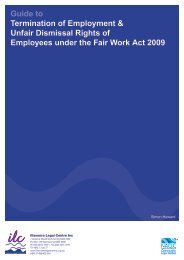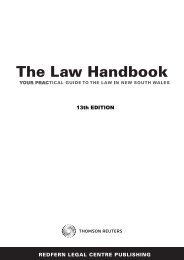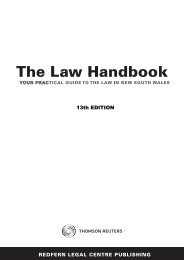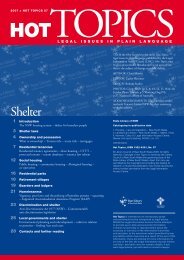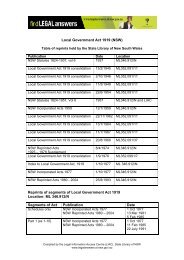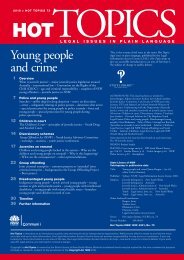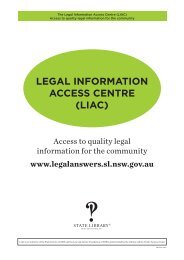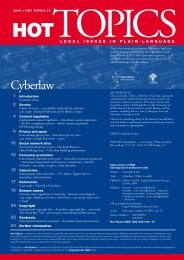Drugs and the law - Hot Topics 59 - Find Legal Answers
Drugs and the law - Hot Topics 59 - Find Legal Answers
Drugs and the law - Hot Topics 59 - Find Legal Answers
You also want an ePaper? Increase the reach of your titles
YUMPU automatically turns print PDFs into web optimized ePapers that Google loves.
Section 23(1A) prohibits <strong>the</strong> ‘cultivation by enhancedindoor means’ of five or more plants for a commercialpurpose. ‘Commercial purpose’ means intending to sellor believing that ano<strong>the</strong>r person intended to sell – section23(6). [Note that <strong>the</strong> offence of (outdoor) cultivation ofcannabis in s 23(1) does not involve any requirement toprove a commercial purpose.]So <strong>the</strong> offence requires <strong>the</strong> cultivation to be:> inside a building or structure <strong>and</strong>> involve growing <strong>the</strong> plant in nutrient enriched water orapplying artificial light or heat or suspending <strong>the</strong> roots<strong>and</strong> spraying <strong>the</strong>m with nutrient solution <strong>and</strong>> involve five or more plants <strong>and</strong>> be done with <strong>the</strong> intention to sell (or <strong>the</strong> beliefthat ano<strong>the</strong>r person intends to sell) <strong>the</strong> cannabisproduced.Offences under section 23(1A) are wholly indictable.They must be dealt with in <strong>the</strong> District Court.offence categoriesThere are now two entries for cannabis as ‘prohibitedplants’ in <strong>the</strong> Schedule (‘cannabis cultivated by enhancedindoor means’ <strong>and</strong> ‘cannabis cultivated by any o<strong>the</strong>rmeans’). The relevant offence categories in <strong>the</strong> Scheduleare as follows:tRaffickableqUantitysmallqUantityinDictableqUantitycommeRcialqUantitylaRGecommeRcialqUantityhydro – 5 50 50 200outdoor – 5 50 250 1000penaltiesCultivation of less than <strong>the</strong> ‘small quantity’ of hydroponicplants (that is, less than 5 plants) is treated <strong>the</strong> same asfor outdoor cannabis plants. If dealt with summarily, <strong>the</strong>maximum penalty is $5500 <strong>and</strong> two years imprisonment(s 30(3)) or $220 000 or ten years if dealt with onindictment (s 32(1)(h)).The maximum penalty for cultivation of 5 to 49hydroponic plants is $385 000 <strong>and</strong> 15 years imprisonment(s 33(2)(b)). For cultivation of 50 or more hydroponicplants, <strong>the</strong> maximum penalty is also $385 000 <strong>and</strong> 15years imprisonment (s 33(2)(b)).For 200 or more hydroponic plants, a ‘large commercialquantity’, <strong>the</strong> maximum penalty is $550 000 <strong>and</strong> 20years imprisonment (s 33(3)(b)).exposing a child to indoor cultivationSection 23A(1) makes it an offence to cultivate ‘a plant’(note <strong>the</strong> singular) by enhanced indoor means <strong>and</strong>‘expose a child’ to <strong>the</strong> cultivation process or to substancesstored for use in cultivation.The maximum penalty for an exposing a child offenceinvolving one to four plants is a fine of $11 000 <strong>and</strong>two years imprisonment if dealt with summarily, or a$264 000 fine <strong>and</strong> 12 years imprisonment if heard onindictment.The maximum penalty for an exposing a child offencethat involves five to 199 plants is a $462 000 fine <strong>and</strong>18 years imprisonment. The maximum penalty for anexposing a child offence that involves 200 or more plantsis a $660 000 fine <strong>and</strong> 24 years imprisonment. Theseoffences are wholly indictable.It is a defence if <strong>the</strong> defendant can prove that <strong>the</strong>exposure did not endanger <strong>the</strong> health <strong>and</strong> safety of <strong>the</strong>child. A child is a person under 16 for <strong>the</strong> purposes of<strong>the</strong>se provisions.ManufacTuring drugsIt is an offence to manufacture, or to take part in <strong>the</strong>manufacture of, a prohibited drug, under section 24.The maximum penalty for manufacture of a prohibiteddrug depends on <strong>the</strong> quantity involved, with <strong>the</strong> samepenalties applying as for supply offences involvingcomparable amounts.The maximum penalty for manufacturing an indictablequantity of a drug is a $220 000 fine <strong>and</strong> 15 yearsimprisonment.For manufacturing a quantity of drugs in <strong>the</strong> commercialrange, <strong>the</strong> maximum penalty is a $385 000 fine <strong>and</strong> 20years jail, <strong>and</strong> for a large commercial quantity, fines of$550 000 <strong>and</strong> life imprisonment.possession of precursorsIt is an offence under section 24A to possess a ‘precursor’intended to be used in <strong>the</strong> manufacture of a prohibiteddrug. Substances defined as precursors are listed inSchedules 1 <strong>and</strong> 2 Drug Misuse <strong>and</strong> Trafficking Regulation2006 (NSW). The Regulation also provides that, forlegitimate uses, records must be kept for any storage orsupply of precursors, including an ‘end user certificate’which includes <strong>the</strong> name <strong>and</strong> address <strong>and</strong> proof ofidentity of <strong>the</strong> end user.The maximum penalty for this offence is a $220 000 fine<strong>and</strong>/or ten years imprisonment.o<strong>the</strong>r offences 13





